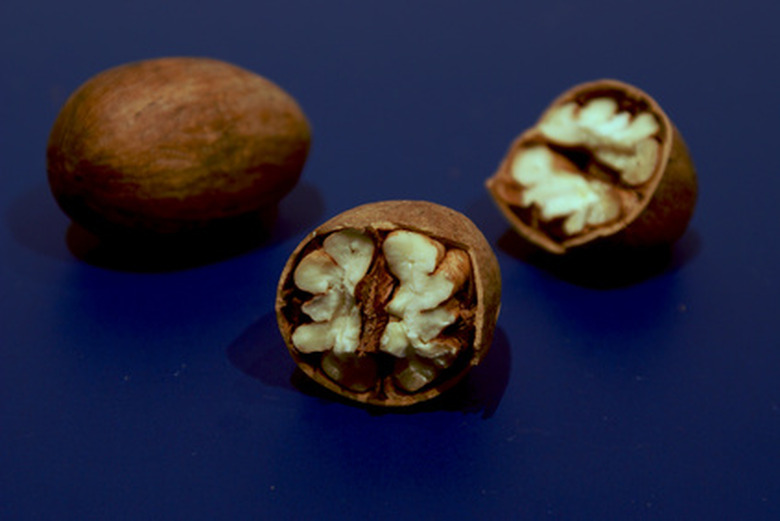How To Grow Pecan Trees In Arizona
Things Needed
- Shovel
- Pick axe or jack hammer
- Ammonium sulfate
- Zinc sulfate
- Sprayer
- Irrigation tubing and emitter
Though native to cooler regions, such as the Midwest and Southeast, pecan trees can be healthy and productive in Arizona yards, even in the lower deserts. The Arizona home gardener would plant pecan trees for the shade these tall and broad trees provide and for the crop of nutritious nuts that mature trees produce. One tree can produce 40 lbs. or more of pecans annually. The tree must be in the ground three or four years before it begins producing. Pecan trees are heavy water users, so they are not good choices for homeowners seeking to create a low water-usage landscape.
Step 1
Select the variety that fits your area. Fruit and nut trees have chilling requirements, which means the number of cumulative hours that are below 45 degrees F but above freezing during the typical winter. This helps promote proper growth of the pecan tree as it emerges from winter dormancy. Pecan trees come in varieties with chilling requirements between 200 and 1,200 hours. In the warm desert areas of Arizona, tree varieties with requirements below 600 hours work best.
- Though native to cooler regions, such as the Midwest and Southeast, pecan trees can be healthy and productive in Arizona yards, even in the lower deserts.
- The Arizona home gardener would plant pecan trees for the shade these tall and broad trees provide and for the crop of nutritious nuts that mature trees produce.
Step 2
Dig a hole several feet deep, fill it with water and test how fast it drains. If it drains within 24 and 48 hours, the soil is adequate. Slower draining soil could indicate the presence of caliche, a hardened calcium carbonate. This must be drilled or punched through. Without proper drainage, the tree can die.
Step 3
Plant a bare root pecan tree in late winter through March so the roots can get a good footing before the spring growth spurt begins. You can plant container trees in early fall–after the worst of the summer heat is over. Dig the hole deep enough so the tree can be planted to the soil line, indicated by the change in color between the tree trunk bark and beginning of the roots. Don't add fertilizer at this time. Refill the hole with the same soil that was removed. Fill the hole with water to push air out of the hole and bring the soil and roots into contact.
- Dig a hole several feet deep, fill it with water and test how fast it drains.
- Dig the hole deep enough so the tree can be planted to the soil line, indicated by the change in color between the tree trunk bark and beginning of the roots.
Step 4
Fertilize the tree with an application of nitrogen such as ammonium sulfate to its base. Fertilize in April, when the pecan tree ends winter dormancy and begins to show new growth. Pecan trees in Arizona soils are also prone to developing zinc deficiency, indicated by brown spots on the new spring leaves. Spray a diluted solution of zinc sulfate directly and generously on the new foliage. Spray at intervals of several weeks for five or six sprayings.
Step 5
Step up the watering schedule in spring to accommodate the needs of the developing foliage. Water enough to penetrate at least 4 feet in the soil. Use a wide watering pattern to reach all the roots, at least 3 feet beyond the dripline, the circle beneath the tree's widest branches. During peak summer temperatures, water once a week. Pecan trees are thirsty in summer as the nuts grow and begin to ripen toward a late fall harvest.
- Fertilize the tree with an application of nitrogen such as ammonium sulfate to its base.
- Step up the watering schedule in spring to accommodate the needs of the developing foliage.
Tip
If the developing pecans start to drop off the tree in the summer, it is a sign the tree needs more water. Use separate sprayers for fertilizing trees and for pesticides. Wash out the fertilizer sprayer between uses.
Warning
Pecan trees are susceptible to infestation by several pests, particularly aphids. The presence of aphids can be seen by the glossy residue they form on the new leaves in spring. In summer, the leaf-footed plant bug can pose problems. You may need to apply spray pesticides.
